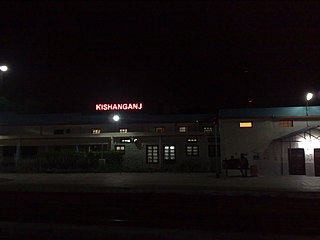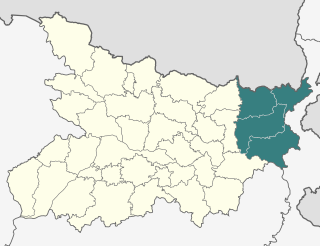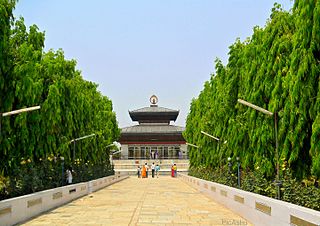Araria is a city and a municipality that is the headquarters of Araria district in the Indian state of Bihar. Araria is situated in the northern part of Bihar.

Kishanganj is a city and district headquarters of Kishanganj district in Purnia division of Bihar state.

Katihar is a city situated in the eastern part of the state of Bihar in India. It is the regional headquarter of Katihar district. It is one of the important cities of Bihar. Also it's a main route of Delhi - Guwahati railway line.
Madhepura is a municipality in Madhepura district in the Indian state of Bihar. It stands at the centre of Kosi ravine, It was called Madhyapura- a place centrally situated which was subsequently transformed as Madhipura into present Madhepura. It is surrounded by Araria and Supaul districts in the north, Khagaria and Bhagalpur districts in the south, Purnia district in the east and Saharsa district in the West.

Purnia (also romanized as Purnea) is the fourth largest city of Bihar and emerging as the biggest economic hub in North Bihar. It serves as the administrative headquarters of both Purnia district and Purnia division in the Indian state of Bihar. It is well known for its favourable climate like Darjeeling and have abundance amount of resources for human settlements and economic activities.

Saharsa is a city and Municipal corporation in the Saharsa District in the eastern part of the state of Bihar, India. It is situated near the eastern banks of the Kosi River. It serves as the administrative headquarters for Saharsa District and is also the Divisional Headquarter of the Kosi Division.
Supaul is a town and a municipality that is headquarters of Supaul district in the Indian state of Bihar. Supaul is the administrative headquarters of this district.

Janaka is a character who appears in the Hindu epic Ramayana as a mighty king of Janakpur who ruled the Kingdom of Videha located in the Mithila region of Nepal and India. His name at birth was Sīradhvaja, and he had a brother named Kushadhvaja. His father's name was Hrasvaroman, a descendant of the king Nimi. The rulers of the Videha kingdom were accorded the title Janaka, meaning 'father' in Sanskrit, and this character is the best-known bearer of the same. Janak is one of the seventeen National heroes of Nepal.

Purnia District is one of the thirty-eight districts of the Indian state of Bihar. The city of Purnia is the administrative headquarters of this district. The city of Purnia has continued its tradition of hoisting the national flag at 12:07 am on every Independence Day since 1947. Purnia district is a part of Purnia Division. The district extends northwards from the Ganges river.

Madhepura district is one of the thirty-eight districts of Bihar state, India, and Madhepura town is the administrative headquarters of this district. Madhepura district is a part of Kosi division.

Supaul district is one of the thirty-eight districts of Bihar, India. The town Supaul is the district's administrative headquarters. The district, which was split from the former Saharsa district on 14 March 1991, occupies 2,410 km2 (931 sq mi).

Katihar district is one of the thirty-eight districts of Bihar state in India, and Katihar city is the administrative headquarters of this district. The district is a part of Purnia Division. It is prominently known for its Katihar Junction Railway Station, which is a Category A station on the Barauni–Guwahati line. It has been included in the Aspirational Districts Program of the Government of India since 2018, to improve its socio-economic indicators.

Kishanganj district is one of the thirty-eight districts of Bihar state, India, and Kishanganj town is the administrative headquarters of this district. Kishanganj district is a part of Purnia division (Seemanchal).

Saharsa is one of the thirty-eight districts of Bihar, India. Saharsa city is the administrative headquarters of this district. Saharsa district is a part of the Kosi Division and it became a district on 1 April 1954 and has subsequently become smaller with other districts being carved from it, most notably Madhepura in 1981.

Purnia division is an administrative geographical unit of Bihar state of India. Purnia is the administrative headquarters of the division. The division consists of Purnia district, Katihar district, Araria district, and Kishanganj district. It was established in 1990. It is also known as Seemanchal. It is a part of the Kosi—Seemanchal subregion of the cultural Mithila region.
Maithils, also known as Maithili people, are an Indo-Aryan ethno-linguistic group from the Indian subcontinent, who speak the Maithili language as their native language. They inhabit the Mithila region, which comprises Northern and Eastern Bihar and Northeastern Jharkhand in India and some adjoining districts of Nepal constituting Madhesh Province in addition to some terai districts of Bagmati and Koshi Provinces. The Maithil region forms an important part of Hinduism as it is said to be the birthplace of Sita, the wife of Ram and incarnation of Lakshmi.

Mithila, also known as Tirhut, Tirabhukti and Mithilanchal is a geographical and cultural region of the Indian subcontinent bounded by the Mahananda River in the east, the Ganges in the south, the Gandaki River in the west and by the foothills of the Himalayas in the north. It comprises certain parts of Bihar and Jharkhand of India and adjoining districts of the Province No. 1, Bagmati Pradesh and Madhesh Province of Nepal. The native language in Mithila is Maithili, and its speakers are referred to as Maithils.
Mithila is a geographical and cultural region located in the Indian subcontinent. It comprises certain parts of Bihar of India and adjoining districts of the eastern Terai of Nepal. The native language is known as Maithili and its speakers are referred to as Maithils. The majority of the Mithila region falls within modern-day India, more specifically in the state of Bihar. Mithila is bounded in the north by the Himalayas, and in the south, west and east by the Ganges, Gandaki and Mahananda respectively. It extends into the southeastern Terai of Nepal. This region was also called Tirabhukti, the ancient name of Tirhut.

Madhesh Province is a Nepalese province in southeastern Nepal. It was formed after the adoption of the Constitution of Nepal. It borders Koshi Pradesh to the east, Bagmati Province to the north, and India’s Bihar state to the south. It has an area of 9,661 km2 (3,730 sq mi) covering about 6.5% of the country's total area. It has a population of 6,126,288 as per the 2021 Nepal census, making it Nepal's most densely populated province and smallest province by area.

Keśin Dālbhya was a king of Panchala during the Late Vedic period, most likely between c. 900 and 750 BCE. He is mentioned prominently in the Taittiriya and Jaiminiya Brahmanas. His maternal uncle was a Kuru king, reflecting the matrimonial alliance between the two kingdoms. His reign saw the establishment of the Panchala kingdom as the dominant political and cultural center of northern India, in the aftermath of the decline and defeat of the Kuru Kingdom by the non-Vedic Salva tribe. The nephew of the Kuru king Ucchaisravas, son of Kuvaya, who had died heirless, he subsequently took over the leadership and ensured the continuation of the Vedic tradition. His dynasty remained in power for many generations; one of his later successors was the philosopher-king Pravahana Jaivali mentioned in the Upanishads.















